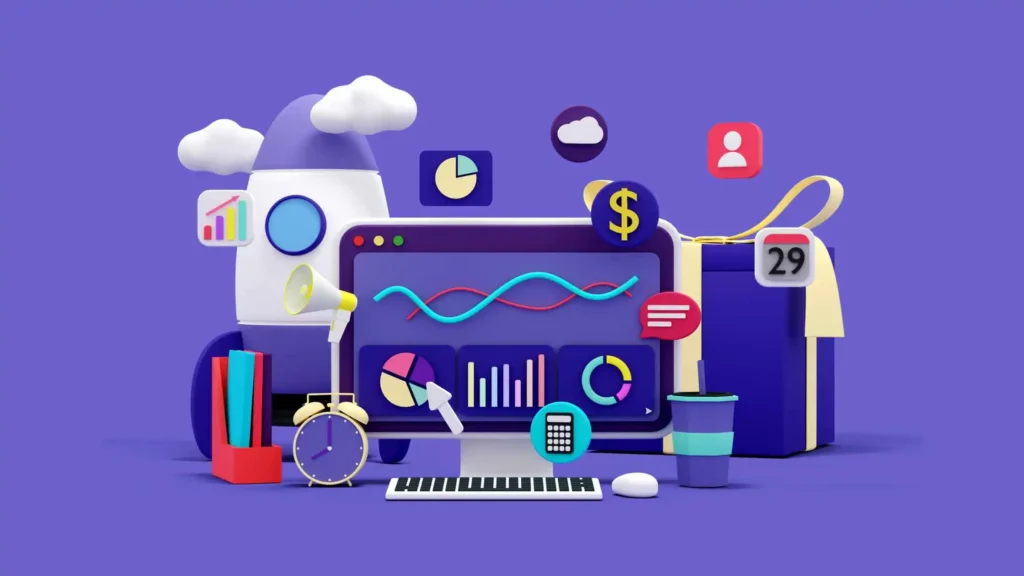Are you looking to integrating Microsoft Power BI with other Microsoft Products? If yes, Congrats! You’re gonna make it happen!
Microsoft Power BI is a powerful business intelligence tool that enables organizations to analyze and visualize their data.
With its extensive features and capabilities, Power BI can be seamlessly integrated with other Microsoft products, allowing businesses to leverage the full potential of their data ecosystem.
In this article, we will explore the process of integrating Microsoft Power BI with other Microsoft products and highlight the benefits it offers.
Whether you are using Office 365, Azure, Dynamics 365, or SharePoint, integrating Power BI can enhance your data analysis and reporting capabilities, providing valuable insights for informed decision-making.

So let’s go ahead!
Integrating Power BI with Office 365
Microsoft Power BI seamlessly integrates with Office 365, providing users with enhanced data analysis and reporting capabilities within familiar productivity applications.
By integrating Power BI with Office 365, you can create interactive reports, dashboards, and visualizations using Excel, Word, and PowerPoint.
The integration allows you to embed Power BI reports and dashboards directly into these applications, making it easier to share insights and collaborate with colleagues.
With real-time data updates and interactive visualizations, you can make data-driven decisions without leaving your Office 365 environment.
Leveraging Power BI in Azure
Azure, Microsoft’s cloud computing platform, offers a wide range of services and tools for data storage, processing, and analytics.
Power BI can be seamlessly integrated with Azure, enabling you to leverage the platform’s capabilities for advanced data analysis and visualization.
With Azure Data Lake Storage, Azure SQL Database, and Azure Analysis Services, you can store and process large volumes of data and connect them to Power BI for interactive reporting and analytics.
The integration between Power BI and Azure empowers businesses to unlock valuable insights from their cloud-based data infrastructure.
Unleashing the Power of Power BI in Dynamics 365
Dynamics 365, Microsoft’s suite of intelligent business applications, can be integrated with Power BI to enhance data analysis and reporting capabilities.
By connecting Power BI to Dynamics 365 applications such as Sales, Customer Service, and Finance, you can gain deeper insights into your business processes.
Power BI allows you to create customized reports and dashboards based on Dynamics 365 data, providing a holistic view of your organization’s performance.
With real-time analytics and interactive visualizations, you can identify trends, spot opportunities, and make data-driven decisions within the Dynamics 365 environment.
Integrating Power BI with SharePoint
SharePoint, Microsoft’s collaborative platform for document management and team collaboration, can be integrated with Power BI to enhance data sharing and visualization capabilities.
By embedding Power BI reports and dashboards into SharePoint sites, you can provide your team with a centralized hub for data analysis and reporting.
The integration allows users to interact with Power BI visualizations directly within SharePoint, facilitating collaboration and enabling better decision-making.
With SharePoint and Power BI working together, you can create a data-driven culture within your organization.
Enhancing Collaboration with Teams and Power BI
Microsoft Teams, the hub for teamwork in Office 365, can be integrated with Power BI to enhance collaboration and data sharing.
By embedding Power BI reports and dashboards into Teams channels and chats, you can provide your team with real-time access to data and insights.
The integration allows users to discuss and analyze data within the context of their conversations, fostering collaboration and enabling data-driven decision-making.
With Teams and Power BI integration, you can transform conversations into actions and drive business success.
Integrating Power BI with Excel
Excel, Microsoft’s popular spreadsheet application, can be seamlessly integrated with Power BI, combining the power of data analysis and visualization.
With Power Query, a feature in Excel, you can connect to various data sources and transform them into meaningful insights.
Once the data is imported into Excel, you can leverage Power BI’s visualization capabilities to create interactive reports and dashboards.
The integration between Power BI and Excel empowers users to explore data, discover patterns, and communicate insights effectively.
Optimizing Data Analysis with Power Automate
Power Automate (formerly known as Microsoft Flow) is a cloud-based service that allows you to create automated workflows between different applications and services.
By integrating Power BI with Power Automate, you can automate data refresh, report distribution, and other repetitive tasks.
For example, you can create a workflow that triggers a data refresh in Power BI whenever new data is added to a SharePoint list.
The integration between Power BI and Power Automate streamlines data analysis processes and improves productivity.
Integrating Power BI with Power Apps
Power Apps, part of the Microsoft Power Platform, enables users to build custom business applications without writing code.
By integrating Power BI with Power Apps, you can embed Power BI reports and dashboards directly into your custom applications.
This integration allows users to access and interact with data visualizations seamlessly within the context of their applications.
Whether you are building a sales dashboard or a customer service portal, the Power BI and Power Apps integration empowers you to create data-driven experiences for your users.
Streamlining Workflows with Power BI and Power Virtual Agents
Power Virtual Agents is a no-code chatbot platform that allows organizations to create and deploy conversational agents.
By integrating Power BI with Power Virtual Agents, you can leverage data insights within your chatbot conversations.
For example, you can create a chatbot that retrieves real-time sales data from Power BI and provides personalized recommendations to customers.
The integration between Power BI and Power Virtual Agents streamlines workflows and enhances customer engagement through intelligent conversations.
Automating Reporting with Power BI and Power Query
Power Query, a feature available in Power BI and Excel, allows users to connect to various data sources, transform data, and create data models.
By integrating Power Query with Power BI, you can automate the process of data extraction, transformation, and loading (ETL).
This integration enables you to build robust data pipelines that refresh automatically, ensuring that your reports and dashboards are always up to date.
With Power BI and Power Query integration, you can save time and effort in data preparation and focus on data analysis and insights.
Integrating Power BI with SQL Server
SQL Server, Microsoft’s relational database management system, can be integrated with Power BI to leverage the power of structured data.
By connecting Power BI to SQL Server, you can create interactive reports and dashboards based on your database tables and views.
The integration allows you to perform advanced data analysis, write complex queries, and visualize data in meaningful ways.
With Power BI and SQL Server integration, you can unlock the insights hidden within your structured data and drive informed decision-making.
Creating Dashboards in Power BI
Power BI offers a rich set of tools and features for creating interactive dashboards that provide a consolidated view of your data.
With drag-and-drop functionality, you can easily design visually appealing dashboards that showcase key metrics, trends, and KPIs.
Power BI allows you to customize the layout, apply filters, and create interactive visualizations such as charts, maps, and tables.
Whether you are monitoring sales performance, tracking project progress, or analyzing financial data, Power BI dashboards provide a comprehensive and real-time view of your business.
Designing Interactive Reports in Power BI
Power BI enables users to design interactive reports that facilitate data exploration and analysis.
With Power BI’s intuitive report authoring tools, you can create visually stunning reports that convey insights effectively.
You can add interactive elements such as slicers, drill-through actions, and bookmarks to enhance user experience and enable deeper data exploration.
Power BI also offers a wide range of visualizations and formatting options to present data in a meaningful and engaging way.
With Power BI, you can transform raw data into compelling narratives that drive action.
Implementing Data Refresh in Power BI
Data refresh is a critical aspect of maintaining up-to-date and accurate reports in Power BI.
Power BI offers various options for data refresh, depending on the data source and requirements.
You can schedule automatic refreshes, trigger refreshes based on data source changes, or manually refresh data on-demand.
Power BI supports a wide range of data sources, including databases, online services, and cloud platforms.
By implementing an effective data refresh strategy in Power BI, you can ensure that your reports and dashboards reflect the latest information and insights.
Securing Power BI Data with Azure Active Directory
Azure Active Directory (Azure AD) provides identity and access management capabilities for cloud applications, including Power BI.
By integrating Power BI with Azure AD, you can enforce secure access to your Power BI content and control user permissions.
Azure AD allows you to authenticate users, implement single sign-on, and apply conditional access policies to protect your data.
With Power BI and Azure AD integration, you can ensure that your data remains secure and only accessible to authorized users within your organization.
Leveraging Power BI Embedded for Application Integration
Power BI Embedded is a service that allows developers to integrate Power BI capabilities into their applications.
With Power BI Embedded, you can embed Power BI reports, dashboards, and visualizations directly into your web or mobile applications.
This integration enables you to provide data analysis and reporting features to your application users without requiring them to have separate Power BI licenses.
Power BI Embedded offers flexible licensing options and powerful APIs, empowering developers to create custom data experiences within their applications.
Integrating Power BI with OneDrive
OneDrive, Microsoft’s cloud storage service, can be integrated with Power BI for seamless data sharing and collaboration.
By connecting Power BI to OneDrive, you can access and analyze data stored in your OneDrive folders directly within Power BI.
The integration allows you to create reports and dashboards based on your OneDrive data and share them with colleagues.
With Power BI and OneDrive integration, you can centralize your data storage and enable real-time collaboration on data analysis projects.
Using Power BI with Power Platform
Power BI is part of the Microsoft Power Platform, which also includes Power Apps and Power Automate.
These three tools work together seamlessly, allowing you to create end-to-end data solutions.
By integrating Power BI with Power Platform, you can connect data from various sources, build custom applications, and automate workflows.
The integration empowers organizations to streamline their data processes, enhance data analysis capabilities, and drive digital transformation.
Integrating Power BI with Yammer
Yammer, Microsoft’s enterprise social networking platform, can be integrated with Power BI to enhance data-driven conversations and collaboration.
By embedding Power BI reports and dashboards into Yammer groups, you can provide your team with a platform to discuss and analyze data in real-time.
The integration allows users to share insights, ask questions, and provide feedback within the context of their conversations.
With Power BI and Yammer integration, you can create a data-driven social environment that fosters collaboration and knowledge sharing.
Integrating Power BI with Visual Studio
Visual Studio, Microsoft’s integrated development environment (IDE), can be integrated with Power BI to enable developers to incorporate data analytics into their applications.
By connecting Power BI to Visual Studio, developers can leverage the Power BI REST API to interact with Power BI artifacts programmatically.
This integration allows developers to embed Power BI reports and dashboards, automate report generation, and customize the user experience.
With Power BI and Visual Studio integration, developers can enhance their applications with powerful data analysis and visualization capabilities.
Leveraging Power BI Mobile App for Data Accessibility
Power BI offers a mobile app that allows users to access their reports and dashboards on the go.
The Power BI mobile app is available for iOS and Android devices, providing a seamless and responsive user experience.
By leveraging the Power BI mobile app, you can stay connected to your data and insights wherever you are.
The app supports interactive exploration of visualizations, data alerts, and collaboration features. With the Power BI mobile app, you can access critical information and make data-driven decisions anytime, anywhere.
Integrating Power BI with Microsoft Teams
Microsoft Teams, the hub for teamwork in Office 365, can be integrated with Power BI to enhance collaboration and data sharing within teams.
By adding Power BI as a tab in Teams channels, you can provide your team with direct access to Power BI reports and dashboards.
This integration allows team members to view, discuss, and analyze data within the Teams environment, promoting data-driven decision-making and fostering collaboration.
With Power BI and Teams integration, you can create a centralized hub for data analysis and teamwork.











